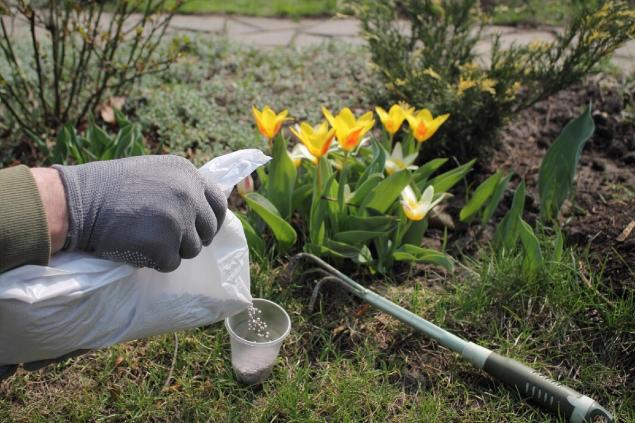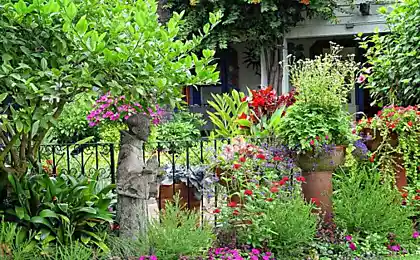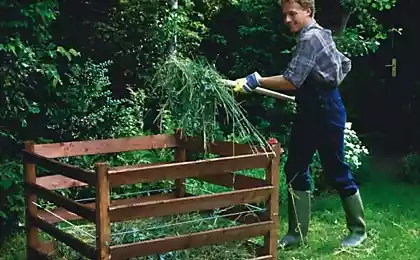124
The rules of spring tulip care
Due to the unpretentiousness and variety of sizes, shapes and colors, tulips are very popular among flower growers.

In our latitudes, the main spring flowers usually bloom for the May holidays.
For lush flowering, they vitally need timely care and additional nutrition - feeding.

And start them with the first warm rays of the March sun, when the reddish tulip sprouts They just come out of the ground.
Tulip care is a moisture-loving plant, but the structure of the root system does not allow it to extract moisture from the deep layers of the earth. Therefore, for a friendly flowering of tulips, abundant and regular watering is necessary.

Fertilization of tulips is better to produce solutions, but if you prefer dry feeding, then make sure that the leaves of the tulips are dry, otherwise they may have burns.

In addition, after dry fertilization of abundant fields, the plot with tulips so that fertilizers along with moisture penetrate into the soil and nourish the roots.
Earlier we told how literally from nothing you can prepare a beautiful organic feeding for plants, equivalent to manure in composition.

You only need three components: water, weeds from your site and a handful of nitrogen fertilizers to improve fermentation. One barrel of 200 liters during the summer with a margin will provide a standard garden plot with food.
Another great feeding for tulips is a solution of yeast. Dilute 1 tablespoon of dry yeast in 1 liter of warm water. Add 40 grams of sugar to the solution. Insist the concentrate for 2-3 hours, then dilute 1 part of the feeding with 5 parts of water.
And finally, tulips respond perfectly to feeding with an infusion of banana peel, tea brewing or coffee grounds. Listening to our advice, you can grow beautiful flowers and make your spring garden bright and beautiful.

In our latitudes, the main spring flowers usually bloom for the May holidays.
For lush flowering, they vitally need timely care and additional nutrition - feeding.

And start them with the first warm rays of the March sun, when the reddish tulip sprouts They just come out of the ground.
Tulip care is a moisture-loving plant, but the structure of the root system does not allow it to extract moisture from the deep layers of the earth. Therefore, for a friendly flowering of tulips, abundant and regular watering is necessary.

Fertilization of tulips is better to produce solutions, but if you prefer dry feeding, then make sure that the leaves of the tulips are dry, otherwise they may have burns.

In addition, after dry fertilization of abundant fields, the plot with tulips so that fertilizers along with moisture penetrate into the soil and nourish the roots.
- 1st feeding
At the beginning of tulip growth, they require mainly nitrogen. As soon as the snow comes off and the soil dries a little, you can spread dry feeding (ammonium nitrate, superphosphate, potassium salt in a ratio of 2: 2: 1) across the plot at the rate of 50 grams per square meter with subsequent irrigation.
- 2nd feeding
When the tulips stretch for 7-10 cm, feed them ammonium nitrate and superphosphate. For 1 square meter you will need 30-40 grams of ammonium nitrate and 20-30 grams of superphosphate, which will need to be dissolved in 10 liters of water.
- 3rd feeding
After the appearance of buds, tulips cease to need nitrogen so badly, so this element is excluded from the list, leaving only phosphorus and potassium.
During budding tulip-feeding is carried out with a solution of mullet (1 part per 30 parts of water), superphosphate (20 grams per 10 liters of water) and potassium sulfuric acid (20 grams per 10 liters of water). - 4th feeding
The fourth feeding is carried out to increase the size of the buds and the duration of flowering. This is done at the very beginning of flowering, when the buds are just beginning to color.
You will need a solution of mullet with superphosphate (40 grams) and potash fertilizer (15 grams). Do not forget about the abundant watering under the root.
Earlier we told how literally from nothing you can prepare a beautiful organic feeding for plants, equivalent to manure in composition.

You only need three components: water, weeds from your site and a handful of nitrogen fertilizers to improve fermentation. One barrel of 200 liters during the summer with a margin will provide a standard garden plot with food.
Another great feeding for tulips is a solution of yeast. Dilute 1 tablespoon of dry yeast in 1 liter of warm water. Add 40 grams of sugar to the solution. Insist the concentrate for 2-3 hours, then dilute 1 part of the feeding with 5 parts of water.
And finally, tulips respond perfectly to feeding with an infusion of banana peel, tea brewing or coffee grounds. Listening to our advice, you can grow beautiful flowers and make your spring garden bright and beautiful.

























